 by "ttyymmnn" (ttyymmnn)
by "ttyymmnn" (ttyymmnn)
Published 09/22/2017 at 12:35
 by "ttyymmnn" (ttyymmnn)
by "ttyymmnn" (ttyymmnn)
Published 09/22/2017 at 12:35
Tags: planelopnik history
; Planelopnik
STARS: 16
!!! UNKNOWN CONTENT TYPE !!!
Welcome to This Date in Aviation History , getting of you caught up on milestones, important historical events and people in aviation from September 20 through September 22.
!!! UNKNOWN CONTENT TYPE !!!
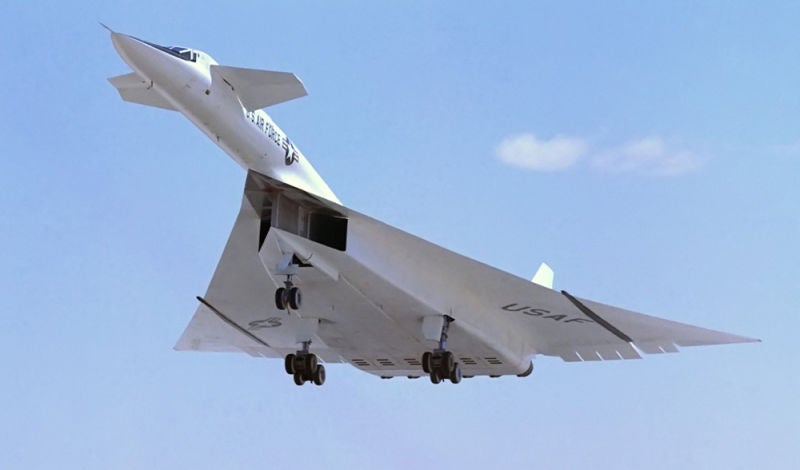
September 21, 1964 – The first flight of the North American XB-70 Valkyrie. With the extraordinary pace of aircraft development, strategic bombing came of age in the Second World War, culminating in the nuclear attacks on Hiroshima and Nagasaki that finally brought an end to the most destructive war in human history. The Nuclear Age had dawned, but the intercontinental ballistic missiles (ICBM) that we know and fear today had not yet become a reality. Attacking an enemy with nuclear weapons was still a mission for long-range bombers, but early postwar bombers, like their predecessors, remained susceptible to fighters and interceptors. But with the advent of supersonic bombers, it was hoped that these planes could fly at altitudes and speeds beyond the reach of contemporary interceptors, and such was the genesis of the radical North American XB-70 Valkyrie. However, by the time the Valkyrie finally took to the air, the ICBM had taken over the role of nuclear attack, and the Valkyrie became an anachronism, a bomber for an earlier age. In 1955, the US Air Force issued a requirement for a new bomber that would have the payload capacity of the Boeing B-52 Stratofortress but the supersonic speed of the Convair B-58 Hustler . Various radical designs were considered, but the rapid development of supersonic science indicated that a large delta wing, with forward canards for added stability and control, would be the most efficient shape for such a bomber. Initial plans were for a bomber that would fly to the target, drop the bomb from lower altitude and “scoot” away from the blast at supersonic speed, but engineers discovered that, from the standpoint of fuel use versus miles traveled, it was more efficient for the aircraft to spend its entire mission at top speed. In the case of the XB-70, that top speed would be Mach 3 at 70,000 feet, propelled by six General Electric YJ93 afterburning turbojets, all mounted side by side. That sort of performance generated a lot of heat so, to cool the aircraft, fuel was pumped through heat exchangers before flowing to the engines. North American engineers also discovered a way to make use of a phenomenon known as compression lift , where the shock wave made by the plane could help create lift. They added drooping wingtips to take full advantage of this effect, with the added benefit of decreasing drag.
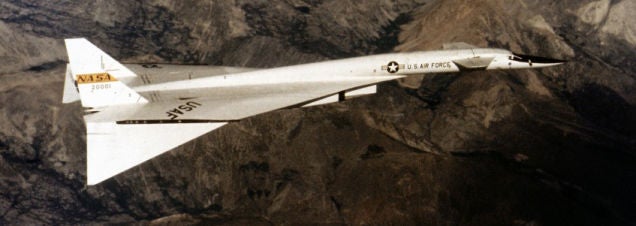
Though the XB-70 would be unreachable by any contemporary fighters, advances in air-to-air missiles suddenly put the whole project in doubt, causing the Air Force to switch its doctrine from high altitude supersonic bombing to low altitude penetration. Thus, the Valkyrie would have to be flown at low levels, where it was barely faster than the B-52, while carrying a smaller payload. Ultimately, the XB-70 became a Cold War Era political football, the stuff of campaign promises and political bargaining, and the project was canceled in 1961. With no real bombing mission for the plane to perform, the two XB-70s that were built became research testbesd for supersonic flight. Valkyrie No. 2 was lost in a mid-air collision during a formation flight photo shoot for engine manufacturer GE that caused the death of two pilots and the serious injury of a third. Aircraft No. 1 continued to serve its research role, with its final supersonic flight taking place in February 1969 when it was flown to the National Museum of the United States Air Force in Dayton, Ohio. (US Air Force photo; NASA photo)
!!! UNKNOWN CONTENT TYPE !!!
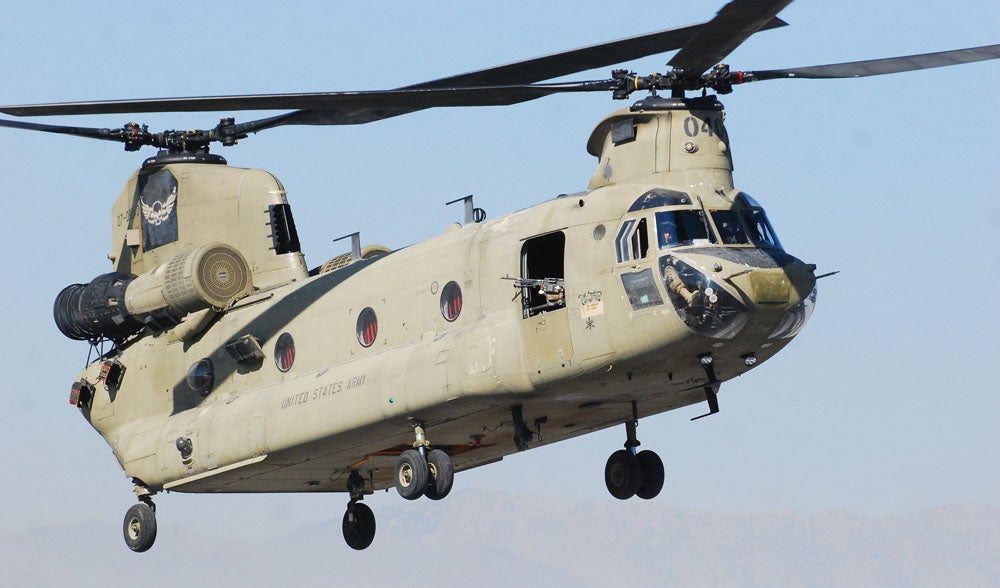
September 21, 1961 – The first flight of the Boeing CH-47 Chinook.
When the US Army placed an order for the
Sikorsky R-4
in 1943, it was the beginning of a relationship with rotor wing aircraft that would eventually give rise to the concepts of
vertical envelopment
that were honed during the Vietnam War. But it soon became clear that, while the helicopter was good at moving soldiers, the Army needed something bigger to lift artillery, heavy equipment, and larger numbers of soldiers. For a time, that job was done by the
Sikorsky CH-37 Mojave
, but work began in 1957 to procure a modern, turbine-powered helicopter as a replacement for the Mojave that could provide even more lifting power and speed than the CH-37's pair of radial engines could supply. The Army was of two minds on the project. One group imagined the new helicopter as being able to carry a full squad of 15 soldiers, while the other group wanted a much larger helicopter capable of moving artillery pieces and other battlefield supplies. The second group carried the day, and Vertol (formerly
Piasecki Helicopter
, which was acquired by Boeing in 1960 and was an early advocate of tandem helicopter design) began working on a tandem helicopter, with two rotors providing extra lift for heavy loads. The first helicopter to come out of this requirement was the YHC-1A, but the Army deemed that it was too small, and it was eventually adopted by the US Marine Corps as the
Boeing Vertol CH-46 Sea Knight
in 1962, where its smaller size would be an advantage for the carrier-based Marines. So Boeing Vertol enlarged the YCH-1A into the YCH-1B, which became the CH-47 Chinook following the Army tradition of naming helicopters after Native American tribes. The new helicopter was powered by two
Lycoming T55
turboshaft engines each producing 4,733 hp and turning counter-rotating propellers, an arrangement that eliminated the need for an anti-torque rotor. The two engines gave the Chinook a top speed of 170 knots, faster than the utility and attack helicopters of its day. They also supplied enough power to carry up to 55 troops or 28,000 pounds of cargo.

The Chinook entered service with the Army in Vietnam in 1965, where it became invaluable in the supply of forward bases, and its lifting power made it possible to haul artillery pieces to remote mountaintop fire bases that were unreachable by roads. Not only was the Chinook popular with the US Army, but it was exported to 23 nations and remains in production, with over 1,200 aircraft built, making it the most-produced tandem helicopter in history. Continuously upgraded since its introduction, the Chinook now has newer, more powerful Lycoming engines (now produced by Honeywell), composite rotor blades, redundant electrical systems and advanced avionics. Along with its fixed-wing heavy lifting counterpart, the Lockheed C-130 Hercules , the CH-47 is one of the few aircraft that has seen a production and service life of over 50 years. (US Army photos)
!!! UNKNOWN CONTENT TYPE !!!

September 21, 1942 – The first flight of the Boeing B-29 Superfortress. In the years leading up to WWII, there were two main schools of thought about how best to use bombers. One was strategic bombing , which sought to defeat the enemy by destroying their means of production of war materiel along with the morale of the civilian population. The other was tactical bombing , in which bombers worked more closely with ground troops to carry out specific battlefield tactics and destroy targets of immediate military value. While Germany, with their Blitzkrieg warfare, became almost wholly invested in the theories of tactical bombing, America and her allies followed the doctrines of strategic bombing, particularly the theories espoused by Italian general Giulio Douhet and American general Billy Mitchell . To that end, the Americans produced ever larger bombers, capable of carrying heavy loads of bombs at great distances. By the time the Superfortress entered service in 1944, it was the most technologically advanced bomber of its era, and even though it arrived late in the war, it had a profound effect on the later stages of the Pacific campaign. Boeing’s work on a pressurized bomber began all the way back in 1938 as an independent project. Then, in 1939, at the urging of Charles Lindbergh, the Army began to pursue a so-called “superbomber,” one that would be capable of carrying 20,000 lbs of bombs over 2,600 miles at a speed of 400 mph. Boeing’s previous work formed the basis for their entry into the competition between Boeing, Consolidated, Lockheed and Douglas to produce the new bomber, and Boeing received an order for two prototypes in August 1940. By May of 1941, the order was increased to 250 production bombers, and then to 500 in January 1942. The Consolidated B-32 Dominator , a more traditional design that was not selected in the initial competition, was ordered into production in small numbers should the production of the B-29 run into difficulties. And as good as the B-29 eventually became, serious problems with the Wright R-3350 Duplex-Cyclone radial engines plagued the early development of the new bomber. Those problems were eventually ironed out, but it wasn’t until the introduction of Pratt & Whitney R-4360 Wasp Major engine after the war that the problems were entirely solved. At the time the B-29 was being developed, the piston-powered aircraft was reaching the zenith of technological advancement, and the Superfortress was at the forefront. In addition to its streamlined shape and the adoption of pressurization, the B-29 was armed with up to ten Browning M2 .50 caliber machine guns in remotely operated, motorized turrets. With onboard targeting computers and a system that could link the guns together, one gunner could control two or more sets of guns to focus the greatest amount of firepower against enemy fighters. And that was only if the fighters could reach them. Flying at nearly 32,000 feet and at speeds of up to 350 mph, the B-29 was almost unreachable by most Japanese fighters.
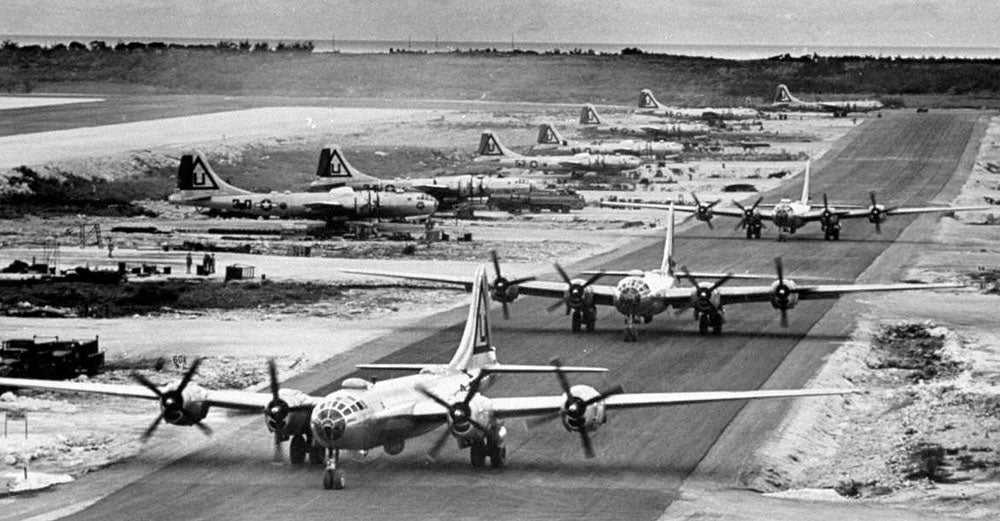
The Army Air Forces originally intended the B-29 to be used against Germany, but delays in production meant that it was flown exclusively in the
Pacific Theater
, where its tremendous range proved to be an asset on long flights over the open waters of the Pacific Ocean. While many WWII-era bombers were retired with the end of the war in 1945, the technologically advanced Superfortress continued its career and flew bombing missions in the Korean War. As the
KB-29
, it served as the basis for one of the first aerial refueling tankers, and the upgraded
B-50
served until 1965, primarily in the reconnaissance role. It also formed the basis for the
Boeing C-97 Stratofreighter
, the
Boeing 377 Stratocruiser
passenger airliner and the
Pregnant/Super Guppy
series of large cargo aircraft. Though nearly 4,000 were produced, only two remain flying today.
(US Army photos)
!!! UNKNOWN CONTENT TYPE !!!
!!! UNKNOWN CONTENT TYPE !!!
!!! UNKNOWN CONTENT TYPE !!!
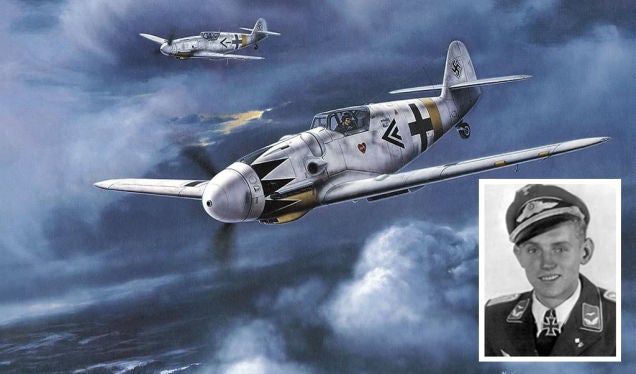
September 20, 1993 – The death of Erich Hartmann. Born on April 19, 1922, Hartmann was taught to fly by his mother, one of the first female glider pilots in Germany. During WWII, Hartmann became the most successful fighter pilot in history with 352 victories to his credit, all but seven coming against Russian aircraft. Over the course of 1,404 sorties, Hartmann, known as the Blonde Knight, was never shot down or forced down by enemy fire, though he did crash land 14 times, all due to mechanical problems or damage caused by the debris from aircraft he had dispatched. Following the war, Hartmann spent 10 years in Soviet prison camps before his release in 1955, and then joined the newly-formed West German Luftwaffe as the first commander of Jagdgeschwader 71 , named after Manfred von Richtofen , better known as the Red Baron. Hartmann resigned from the Luftwaffe in 1970 over his opposition to the Luftwaffe’s adoption of the Lockheed F-104G Straighter and ended his career as a flight instructor before his death at age 71. (Hartmann photo author unknown; Bf 109 illustration by Jerry Crandall)
!!! UNKNOWN CONTENT TYPE !!!
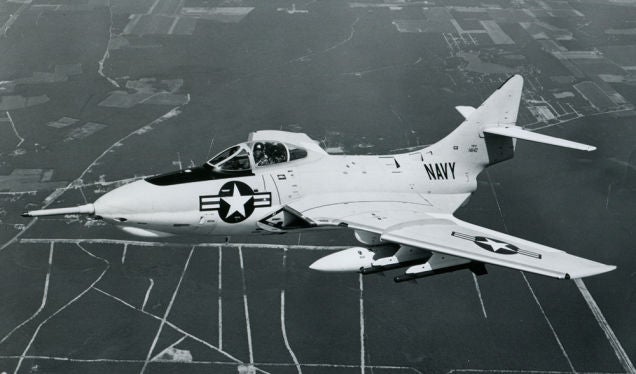
September 20, 1951 – The first flight of the Grumman F9F (F-9) Cougar,
a carrier-based fighter developed for the US Navy. Orginally conceived as an improved version of the
Grumman F9F Panther
, the Cougar was such a significant upgrade to its predecessor that the Navy gave it a new name, even though it was essentially a Panther with swept wings and much more powerful engines. The development of the swept-wing Cougar was spurred by the arrival of the
Mikoyan-Gurevich MiG-15
over Korea, though the Panther was too late to see service in the war, and the Cougar was replaced by the
Grumman F11F Tiger
and
Vought F8U Crusader
before the outbreak of the Vietnam War. Following their retirement from Navy service, many Cougars ended their life as as QF-9 target drones.
(US Navy photo)
!!! UNKNOWN CONTENT TYPE !!!
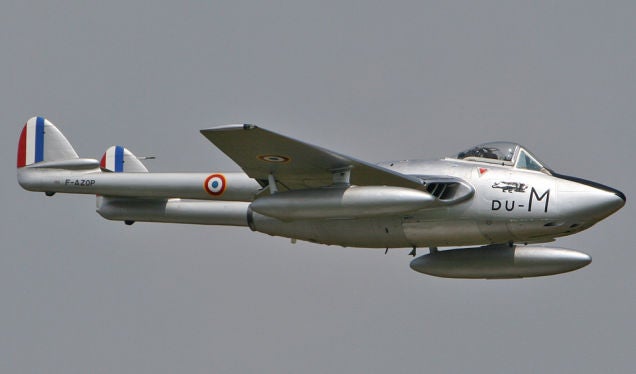
September 20, 1943 – The first flight of the de Havilland Vampire,
the second jet fighter to enter service with the RAF following the
Gloster Meteor,
and the first to use a single engine. It is notable for the twin tail design, with the engine housed in a central, egg-shaped fuselage. This arrangement shortened the tailpipe and allowed full use of the limited power available in early turbojet engines. The Vampire entered service in 1945, where they acted as a ground attack aircraft while the Meteor took on the role of fighter. Vampires saw action in the
1948 Arab-Israeli War
, the
Malayan Emergency
, and the
Rhodesian Bush War
, and were phased out by the RAF by the end of the 1950s. The last export Vampires were retired by the Rhodesian Air Force in 1979.
(Photo by Peter Bakema via
Wikimedia Commons
)
!!! UNKNOWN CONTENT TYPE !!!
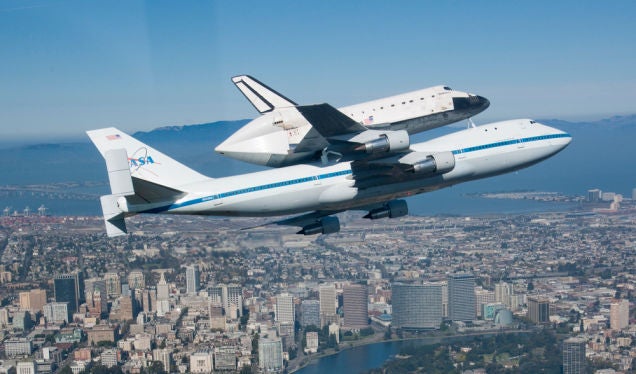
September 21, 2012 – The Space Shuttle flies atop the Shuttle Carrier Aircraft (SCA) for the last time.
After the end of the
Space Shuttle program
in 2011, the retired Shuttles were distributed to various museums and sites around the country.
Endeavour
was the last to be delivered and, during its ferry flight, the SCA made low passes over Florida’s Space Coast and NASA centers in Mississippi and Louisiana before landing in Houston to refuel. Next, they flew over the
White Sands Test Facility
in New Mexico, over Tucson, Arizona as a tribute to Congresswoman
Gabrielle Giffords
, then on to
Edwards Air Force Base
in California where many Shuttle landings took place. On its final day, the SCA and
Endeavour
made low level passes over Sacramento, San Francisco, Silicon Valley, and Los Angeles, before landing at Los Angeles International Airport.
(NASA Photo)
!!! UNKNOWN CONTENT TYPE !!!
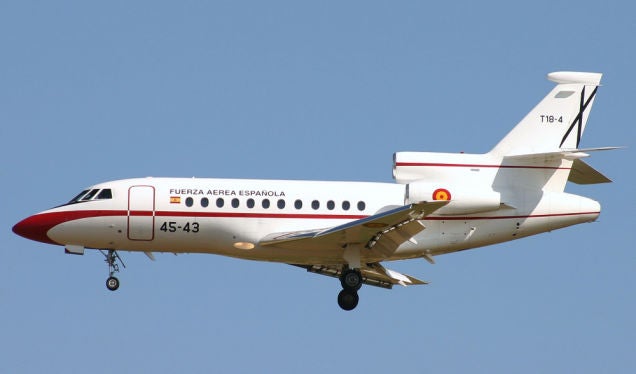
September 21, 1984 – The first flight of the Dassault Falcon 900,
a business jet produced by
Dassault Aviation
of France and, with its sister ship the
Falcon 7X
, the only trijets currently in production. The Falcon 900 is the continuation of the line of Falcon jets that began with the
Falcon 20
and continued with the
Falcon 50
. With a crew of 2, the Falcon 900 can accommodate up to 19 passengers, and its three
Honeywell TFE731
turbofans provide a top speed of Mach 0.87 and an intercontinental range of over 4,000 miles. More than 500 have been built since production began in 1984, and it remains in production today.
(Photo by Luc Verkuringen via
Wikimedia Commons
)
!!! UNKNOWN CONTENT TYPE !!!
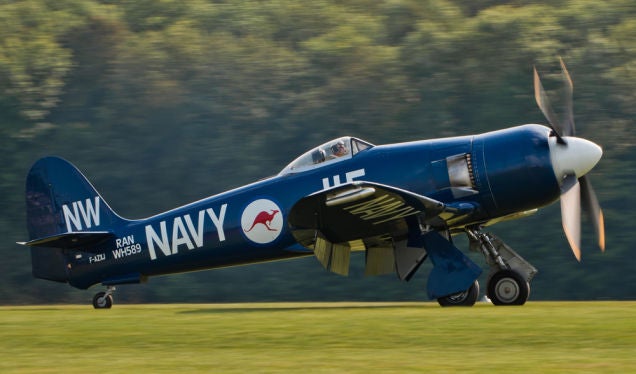
September 21, 1945 – The first flight of the Hawker Sea Fury,
a fighter developed for the Royal Air Force during WWII. When the RAF canceled their order with the end of the war, the fighter was developed into a carrier-based version for the Royal Navy. Powered by a
Bristol Centaurus
18-cylinder radial engine, the Sea Fury was the last propeller-driven fighter to enter service with the Royal Navy and, with a top speed of 460 mph, one of the fastest single piston-engined aircraft ever built. Introduced in 1947 and sold to nine export countries, the Sea Fury saw action during the Korean War, and was flown by the Cuban
Fuerza Aérea Revolucionaria
(Revolutionary Air Force) during the
Bay of Pigs Invasion
of 1961. A total of 864 were produced, and the last Sea Furys were retired by the Burmese Air Force in 1968.
(Photo by Julian Herzog via
Wikimedia Commons
)
!!! UNKNOWN CONTENT TYPE !!!

September 22, 2006 – The Grumman F-14 Tomcat is retired by the US Navy.
Developed after the the US Navy’s rejection of the
General Dynamics F-111B
carrier-based interceptor, the F-14 became the Navy’s primary fighter, though it retained the engines, weapons system and variable geometry wing of its unsuccessful predecessor. The Tomcat entered service with the US Navy in 1974, replacing the
McDonnell Douglas F-4 Phantom II
, and served as the Navy’s principal air superiority fighter while also performing fleet defense and reconnaissance missions. With the arrival of the
Boeing F/A-18E/F Super Hornet
in 1999, the Tomcat was phased out, with its official retirement taking place in 2006 after 32 years of service. Many Tomcats reside in museums, but retired operational F-14s were scrapped by the US government to prevent their parts being obtained by Iran.
(US Navy Photo)
!!! UNKNOWN CONTENT TYPE !!!
!!! UNKNOWN CONTENT TYPE !!!
!!! UNKNOWN CONTENT TYPE !!!
!!! UNKNOWN CONTENT TYPE !!!
!!! UNKNOWN CONTENT TYPE !!!
!!! UNKNOWN CONTENT TYPE !!!
!!! UNKNOWN CONTENT TYPE !!!
If you enjoy these Aviation History posts, please let me know in the comments. And if you missed any of the past articles, you can find them all at Planelopnik History . You can also find more stories about aviation and aviators at Wingspan and Planes You’ve (Probably) Never Heard Of .
!!! UNKNOWN CONTENT TYPE !!!
 "benjrblant" (benjblant)
"benjrblant" (benjblant)
09/22/2017 at 14:03, STARS: 3
I read almost every one of these. I have you to thank for my increased vocabulary regarding aerospace terminology. See how it’s improved!
little wing thingy -> winglet
double wing thingy -> scimitar winglet
big tortilla chip -> delta wing
ear wing things -> canard
 "Bman76 (hates WS6 hoods, is on his phone and has 4 burners now)" (bman76-4)
"Bman76 (hates WS6 hoods, is on his phone and has 4 burners now)" (bman76-4)
09/22/2017 at 14:03, STARS: 4
Also, the groundbreaking for the Home For Doc was today.
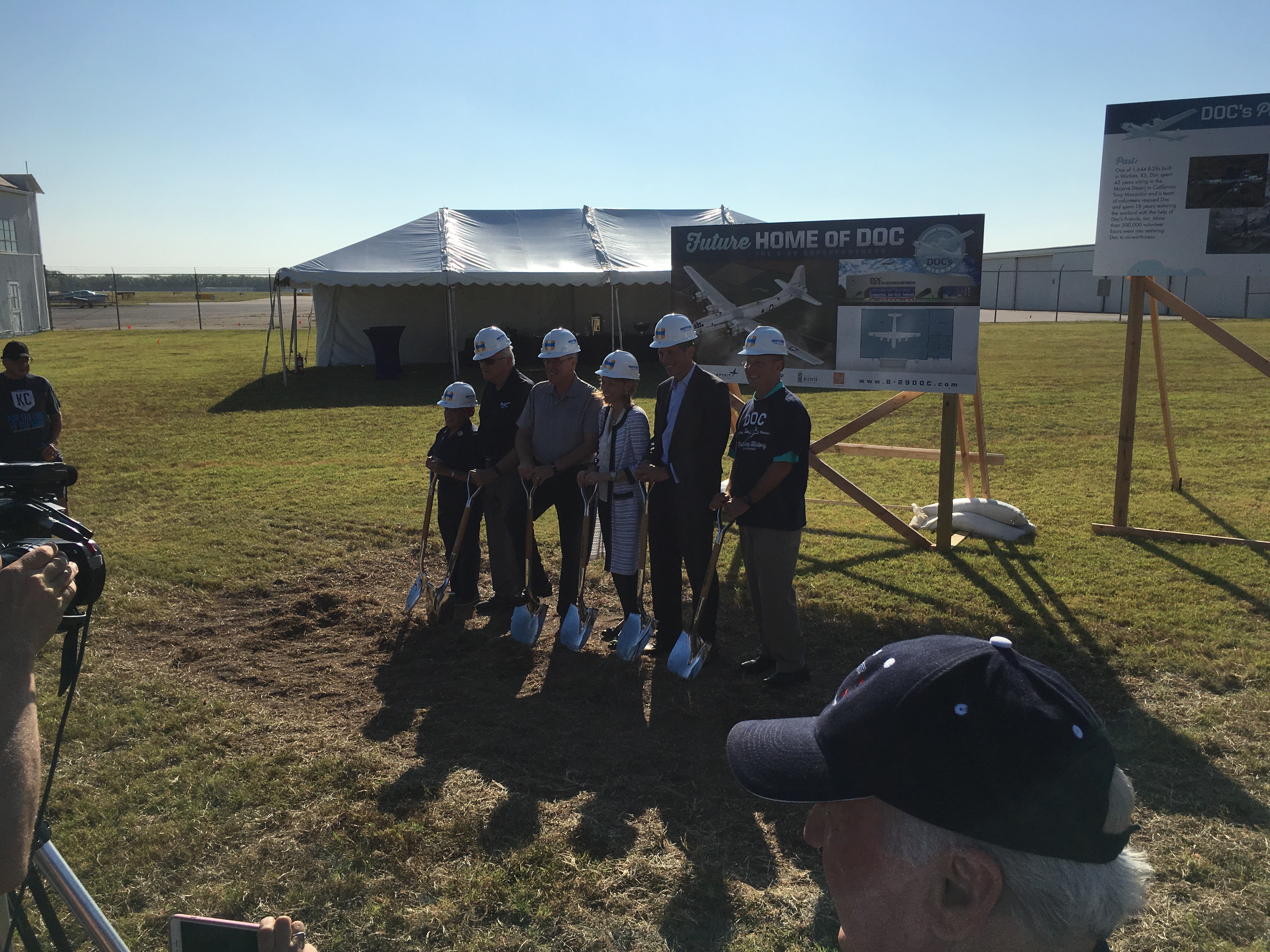


^Real Rosie The Riveter who built Doc (and all the other B-29s that came out of Wichita)

09/22/2017 at 14:20, STARS: 1
F-14s!
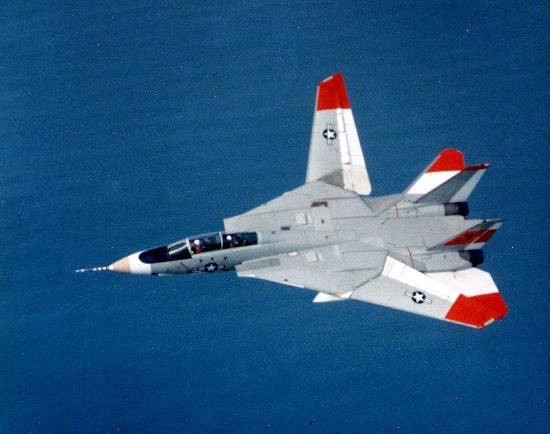
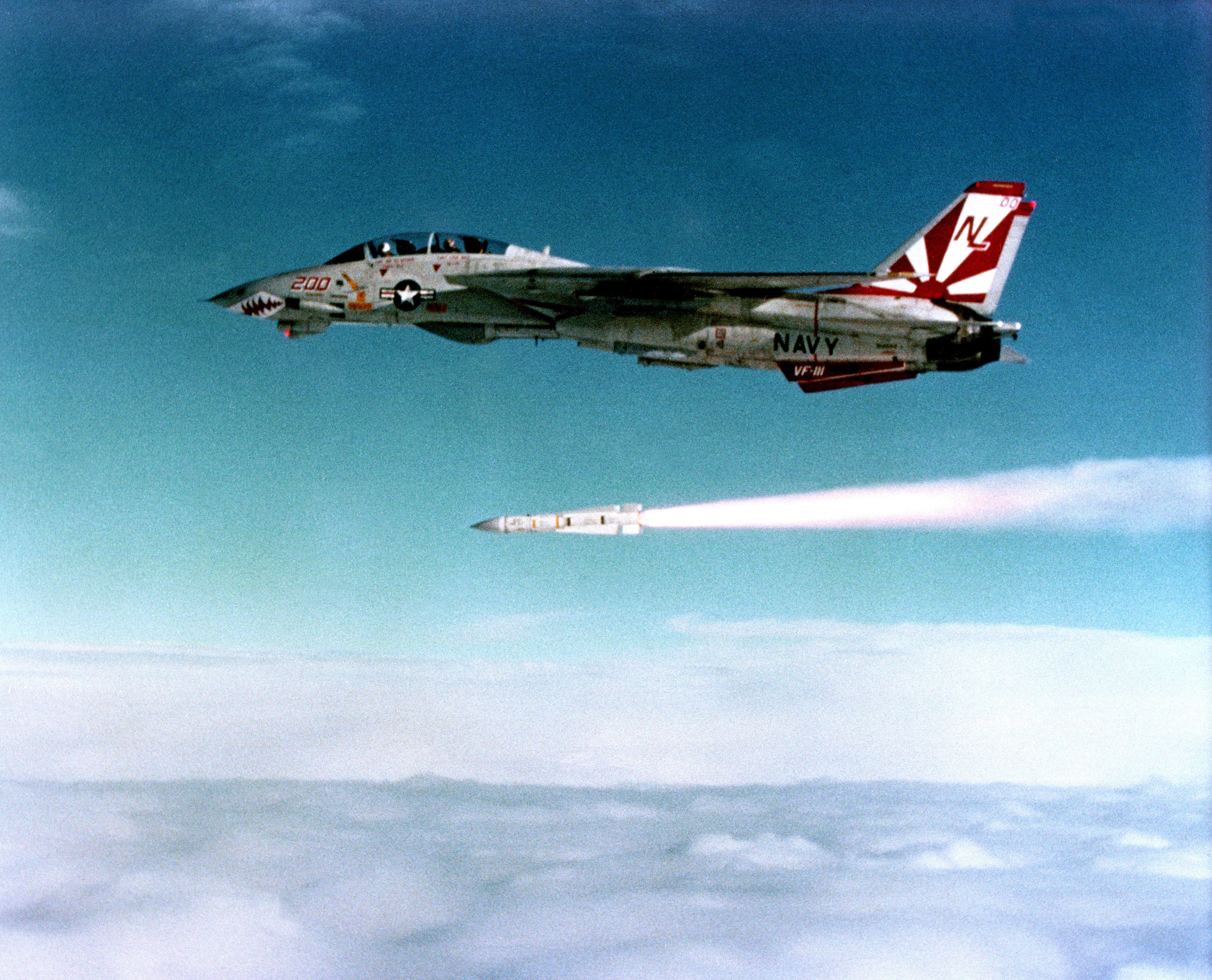
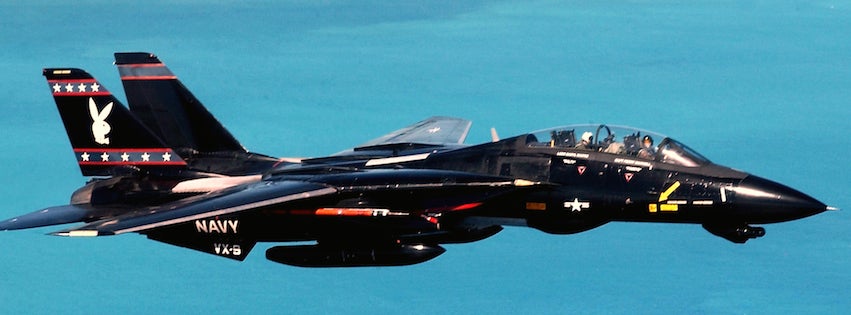
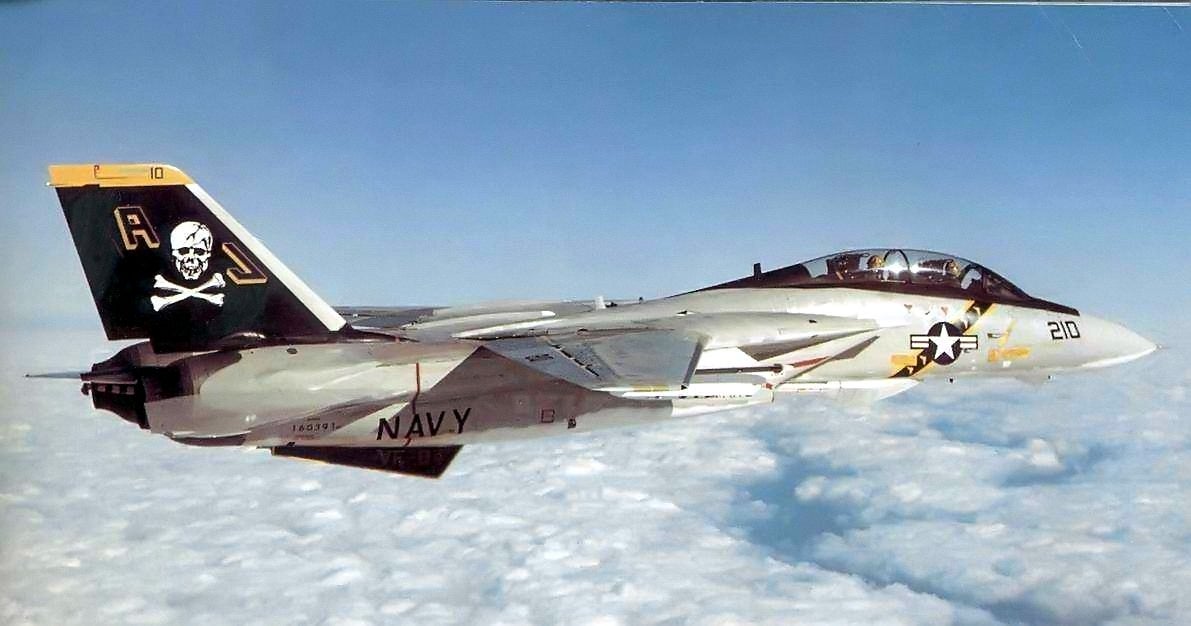
And what could have been (and may still be!)
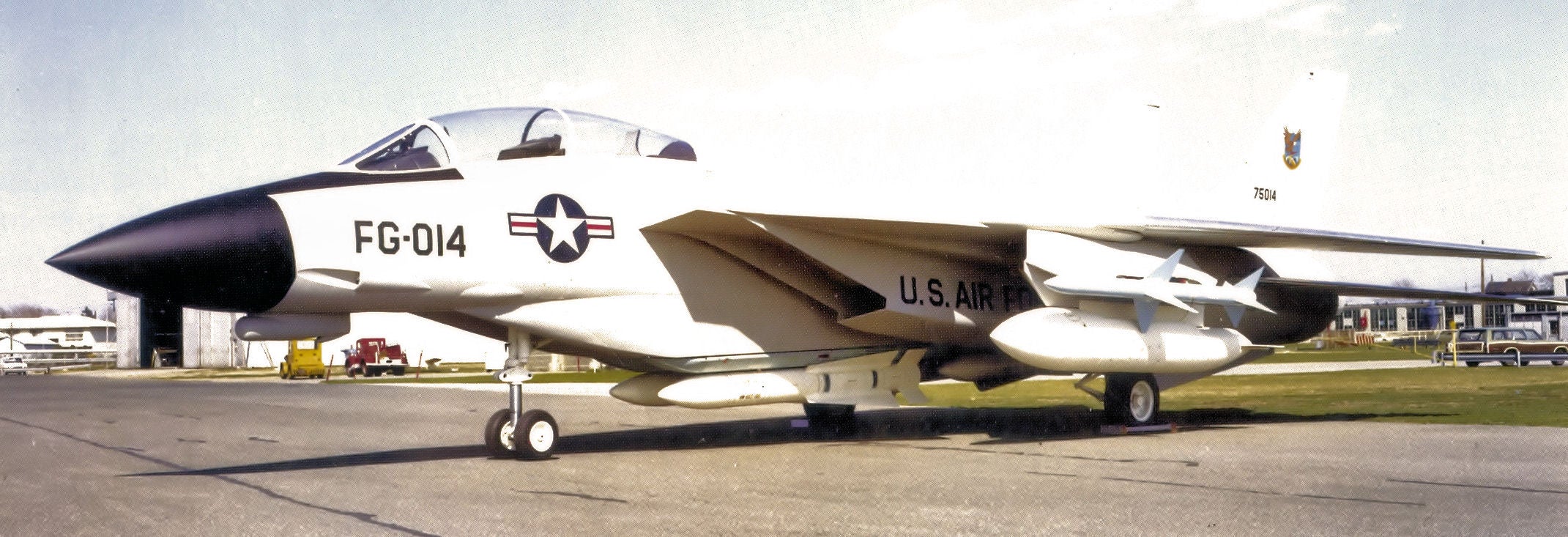

 "WilliamsSW" (williamssw)
"WilliamsSW" (williamssw)
09/22/2017 at 15:16, STARS: 1

Gratuitous shot of Doc’s interior I took in Oshkosh. Note the center cap on the control wheel, and the upper right corner of the panel.
 "ttyymmnn" (ttyymmnn)
"ttyymmnn" (ttyymmnn)
09/22/2017 at 18:22, STARS: 2
Fantastic! I’ve often said that I write mostly for myself, but if I can teach some folks along that way then it’s just icing on the cake. Thanks for reading, and I’ll keep writing.
 "ttyymmnn" (ttyymmnn)
"ttyymmnn" (ttyymmnn)
09/22/2017 at 18:23, STARS: 1
There are no gratuitous shots of such a beautiful aircraft. I love the wheel. What an awesome touch.
 "ttyymmnn" (ttyymmnn)
"ttyymmnn" (ttyymmnn)
09/22/2017 at 18:27, STARS: 2
The should have built the Super Tomcat. It would have kicked ass.I like that stealthy rendering.
 "WilliamsSW" (williamssw)
"WilliamsSW" (williamssw)
09/22/2017 at 18:32, STARS: 0
I especially like the upper right corner of the panel - where it says “Boeing B-29 Superfortress”.
 "ttyymmnn" (ttyymmnn)
"ttyymmnn" (ttyymmnn)
09/22/2017 at 18:35, STARS: 2
I wonder if the Russians copied that too. During the war, they got their hands on one and copied it rivet for rivet, right down to putting “Boeing” on the rudder pedals. Then they built a shit ton of them and called it the Tupolev Tu-4.
 "WilliamsSW" (williamssw)
"WilliamsSW" (williamssw)
09/22/2017 at 18:46, STARS: 1
I wouldn’t *think* they’d do that - - but I wouldn’t expect them to put ‘Boeing’ on the rudder pedals, either. Can’t seem to find an interior shot of a Tu-4.